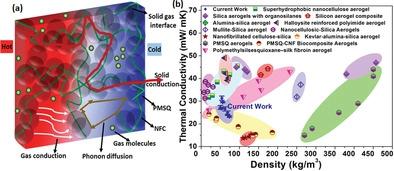当前位置:
X-MOL 学术
›
Macromol. Rapid Commun.
›
论文详情
Our official English website, www.x-mol.net, welcomes your
feedback! (Note: you will need to create a separate account there.)
Surfactant Assisted In Situ Synthesis of Nanofibrillated Cellulose/Polymethylsilsesquioxane Aerogel for Tuning Its Thermal Performance
Macromolecular Rapid Communications ( IF 4.2 ) Pub Date : 2022-10-14 , DOI: 10.1002/marc.202200628 Pragya Gupta 1 , Manoj Sathwane 1 , Monika Chhajed 1 , Chhavi Verma 1 , Yves Grohens 2 , Bastien Seantier 2 , Ashish K Agrawal 3 , Pradip K Maji 1
Macromolecular Rapid Communications ( IF 4.2 ) Pub Date : 2022-10-14 , DOI: 10.1002/marc.202200628 Pragya Gupta 1 , Manoj Sathwane 1 , Monika Chhajed 1 , Chhavi Verma 1 , Yves Grohens 2 , Bastien Seantier 2 , Ashish K Agrawal 3 , Pradip K Maji 1
Affiliation

|
Nanofibrillated cellulose (NFC) and polymethylsilsesquioxane (PMSQ) based aerogel are prepared by the sol-gel method. The objective of this work is to study the impact of surfactant and base catalyst on the thermal and mechanical performance of the corresponding aerogel. The rheological premonitory assists in predicting the bulk properties of the aerogel. The chemical structure of the aerogel is studied by Fourier-transform infrared spectroscopy (FTIR), X-ray diffraction (XRD), X-ray photoelectron spectroscopy (XPS), and solid-state nuclear magnetic resonance (NMR). X-ray microtomographic (XMT) analysis confirms the homogeneous and monolithic structure of the aerogel. The lowest thermal conductivity is achieved as 23.21 mW m−1 K−1 with V-0 and HBF rating through UL-94 test. Thermal performance of aerogels is cross-verified through modeling and simulation in COMSOL multiphysics platform. The mechanical properties of aerogel are evaluated by monolithic compression test in axial and radial compression test up to 90% strain, cyclic compression loading–unloading, and reloading test, flexural test, and dynamic mechanical analysis. The time-temperature analysis has shown around 5 °C temperature difference in the middle of the room after using the aerogel panel at the exposed surface, which assists in the practical application of the synthesized aerogel panel.
中文翻译:

表面活性剂辅助原位合成纳米原纤化纤维素/聚甲基倍半硅氧烷气凝胶以调节其热性能
采用溶胶-凝胶法制备了基于纳米原纤化纤维素 (NFC) 和聚甲基倍半硅氧烷 (PMSQ) 的气凝胶。这项工作的目的是研究表面活性剂和碱催化剂对相应气凝胶的热性能和机械性能的影响。流变预兆有助于预测气凝胶的体积特性。通过傅里叶变换红外光谱 (FTIR)、X 射线衍射 (XRD)、X 射线光电子能谱 (XPS) 和固态核磁共振 (NMR) 研究了气凝胶的化学结构。X 射线显微断层扫描 (XMT) 分析证实了气凝胶的均匀和整体结构。最低导热系数达到 23.21 mW m −1 K −1通过 UL-94 测试具有 V-0 和 HBF 等级。气凝胶的热性能通过 COMSOL 多物理场平台中的建模和仿真进行交叉验证。通过高达90%应变的轴向和径向压缩试验中的整体压缩试验、循环压缩加载-卸载和再加载试验、弯曲试验和动态力学分析来评估气凝胶的力学性能。时间-温度分析表明,在暴露表面使用气凝胶面板后,房间中间的温差约为 5 °C,这有助于合成气凝胶面板的实际应用。
更新日期:2022-10-14
中文翻译:

表面活性剂辅助原位合成纳米原纤化纤维素/聚甲基倍半硅氧烷气凝胶以调节其热性能
采用溶胶-凝胶法制备了基于纳米原纤化纤维素 (NFC) 和聚甲基倍半硅氧烷 (PMSQ) 的气凝胶。这项工作的目的是研究表面活性剂和碱催化剂对相应气凝胶的热性能和机械性能的影响。流变预兆有助于预测气凝胶的体积特性。通过傅里叶变换红外光谱 (FTIR)、X 射线衍射 (XRD)、X 射线光电子能谱 (XPS) 和固态核磁共振 (NMR) 研究了气凝胶的化学结构。X 射线显微断层扫描 (XMT) 分析证实了气凝胶的均匀和整体结构。最低导热系数达到 23.21 mW m −1 K −1通过 UL-94 测试具有 V-0 和 HBF 等级。气凝胶的热性能通过 COMSOL 多物理场平台中的建模和仿真进行交叉验证。通过高达90%应变的轴向和径向压缩试验中的整体压缩试验、循环压缩加载-卸载和再加载试验、弯曲试验和动态力学分析来评估气凝胶的力学性能。时间-温度分析表明,在暴露表面使用气凝胶面板后,房间中间的温差约为 5 °C,这有助于合成气凝胶面板的实际应用。











































 京公网安备 11010802027423号
京公网安备 11010802027423号